
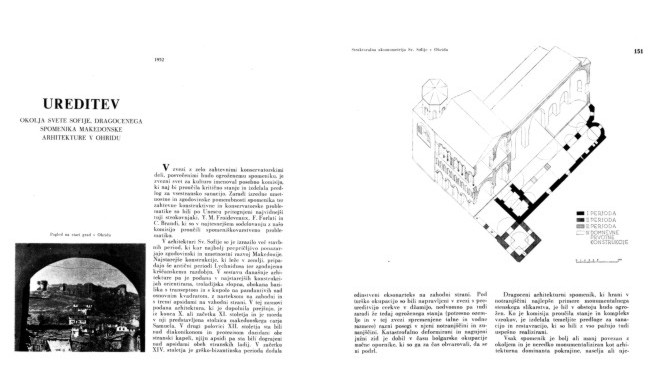
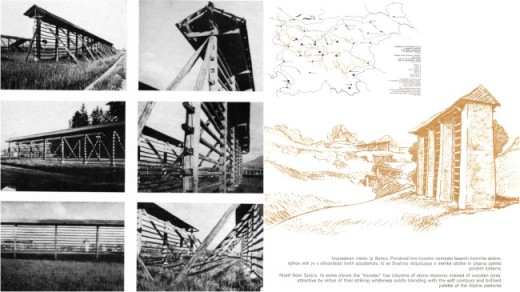
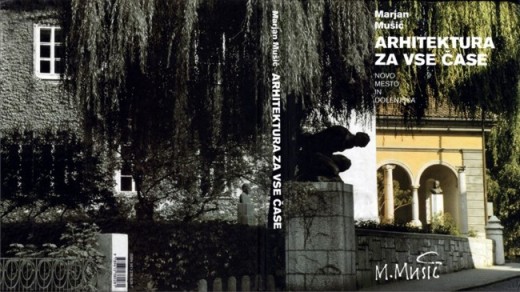
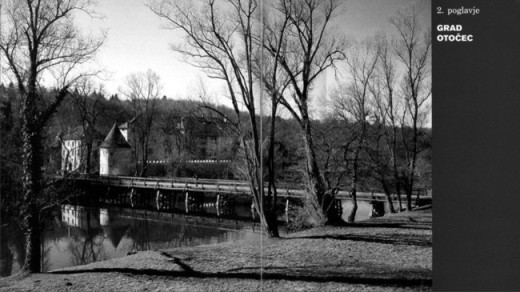
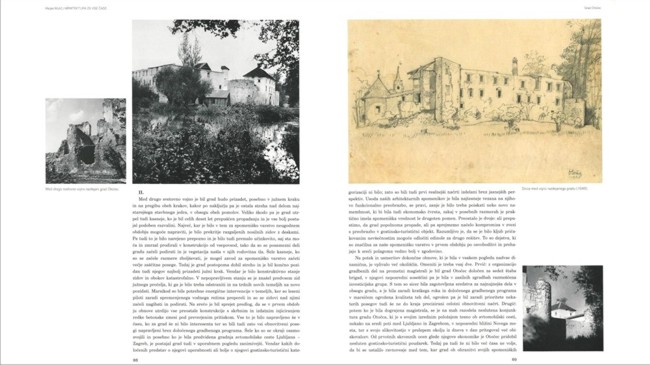
|
Architecture and Time Založba Obzorja, Maribor, 1963 Great architects, Volume I, II and III Založba Obzorja, Maribor, 1965, 1966, 1968 Znameniti Slovenci, Partizanska knjiga, Ljubljana, 1980, Architecture of Slovenian hayrack Cankarjeva založba, Ljubljana, 1970 Architecture for all times Atelje Marko Mušič, Ljubljana, 2002, ISBN 961-238-028-7 Arhitektura in čas / Architecture and Time Založba Obzorja, Maribor, 1963 V knjigi Arhitektura in čas (1963) je Marjan Mušič objavil lastni izbor najpomembnejših razprav in člankov, ki jih je razporedil v tri značilna, pomembna in pomenljiva poglavja: v Vrednotenje virov (I), Ohranjevanje izročila (II) in v Zglede in pobude (III). Če so v prvem poglavju temeljna razmišljanja o slovenski ljudski umetnosti, o arhitekturi kozolca, spomenika slovenske ljudske ustvarjalnosti, o lesu v slovenskem ljudskem stavbarstvu, o načrtnem urejevanju slovenskih vasi ali o vplivnih področjih med stilno arhitekturo in slovenskim ljudskim stavbarstvom v srednjem veku, so v drugem poglavju predstavljene številne izstopajoče téme in problematike, pri katerih je sodeloval tudi sam. Tako obnova Evfrazije bazilike v Poreču, problemi rekonstrukcije in regeneracije Peristila Dioklecijanove palače v Splitu, preureditve v Novem mestu glede na regeneracijo historičnih mestnih jeder, prenova gradu Otočca in obnova cerkve sv. Sofije v Ohridu. V tretjem delu pa je objavil izbor zapisov o pomembnih ustvarjalcih arhitekture. Med njimi so Michelozzo di Bartolomeo, Sinan in Leonardo pa tudi Jože Plečnik, Maks Fabiani, Ivan Vurnik in Edo Ravnikar. In the book, Architecture and Time (1963) Marjan Mušič published his own selection of the most important discussions and articles, which he arranged into three significant, important and meaningful chapters: Evaluation of sources (I) Keeping up the tradition (II) and Examples and initiatives (III). If there are reflections on Slovenian vernacular art in the first chapter, the architecture of a hayrack, a monument of Slovenian folk creativity, about wood in Slovenian vernacular architecture, about the structured editing of Slovenian villages or about influential areas between stylistic architecture and Slovenian folk architecture in the Middle Ages, in the second chapter a number of prominent themes and controversial points are presented, in which he himself participated. Among them the restoration of Euphrasios basilica in Poreč, problems of reconstruction and regeneration of Peristile Diocletian's Palace in Split, renewals in Novo Mesto in relation to the regeneration of historic city centers, renovation of the castle Otočec and restoration of the church of St. Sophia in Ohrid. In the third part he published a selection of records on important architects. Among them are Michelozzo di Bartolomeo, Sinan and Leonardo as well as Jože Plečnik, Max Fabiani, Ivan Vurnik and Edo Ravnikar. Veliki arhitekti I, II, III / Great architects volume I, II and III Založba Obzorja, Maribor, 1965, 1966, 1968 Ta izbor, zapise o temeljnih osebnostih ustvarjanja arhitekture je Marjan Mušič kasneje razširil na celotno obdobje arhitekturne zgodovine in objavil v treh znamenitih knjigah (1965 – 1968). Veliki arhitekti v prvem delu obsegajo velike ustvarjalce od Imenhotepa do Pilgrama, torej od egipčanske do gotske arhitekture, v drugem delu od Brunelleschija do Ledouxa, torej od zgodnje renesanse do zaključka klasičnega obdobja evropske arhitekture (torej do konca XVIII. stoletja) in v tretjem delu od Labrousta do Aalta, torej obdobje od (začetka) XIX. pa do začetka druge polovice XX. stoletja. Sem, ob pionirje in velikane moderne arhitekture, ob Gaudija, Loosa, Mendelsohna, Perreja, Wrighta, Gropiusa, van der Roheja, Corbusiera in Aalta, je brez pridržkov in prislovične slovenske sramežljive boječnosti uvrstil tudi znamenita domača, naša arhitekta Maksa Fabianija in Jožeta Plečnika.Knjige je odlično, z izjemnim smislom za preglednost in jasnost obsežnega gradiva ter z polnim likovnim občutkom sozvočja ilustracij in oblikovanja strani opremil arhitekt Marjan Mušič mlajši. This selection, records on prominent architects, Marjan Mušič later expanded into an entire period of architectural history that he published in three famous books (1965 - 1968). First part of the Great architects volumes include major artists from Imenhotep to Pilgrim, thus from Egyptian to Gothic architecture, in the second part he included periods from Brunelleschija to Ledoux, thus from the early Renaissance to the end of the classical period of European architecture (i.e. until the end of the XVIII. Century) and in the third part a period from Labroust to Aalto, thus periods from (beginning) of XIX. Century until the beginning of the second half of the XX. Century. Here he placed along with the pioneers and the greats of modern architecture, along with Gaudi, Loos, Mendelsohn, Perre, Wright, Gropius, van der Rohe, Corbusier and Aalto, unqualified and without proverbial Slovenian shyness the famous domestic architects, architect Maks Fabiani and Jože Plečnik. The book is excellent for it embodies an exceptional sense for structure and clarity of the extensive material and with a full sense of visual harmony of illustrations and pages designed by architect Marjan Mušič Jr. Jože Plečnik Znameniti Slovenci, Partizanska knjiga, Ljubljana, 1980, Po številnih proučevanjih, lastni izkušnji ter bližnjem, prijateljskem odnosu s svojim učiteljem in vzornikom, po celi vrsti razprav in člankov, predavanj, utemeljitev in oznak njegove umetnosti pa tudi spopadov in zamer, ki jih je bil deležen ob zavzemanju za mojstrovo osebnost in delo v povojni ihti sovraštva in razvrednotenja, je Marjan Mušič napisal knjigo Jože Plečnik, ki je leta 1980 prvič izšla v zbirki Znameniti Slovenci. V knjigi so temeljna spoznanja o izvorih, značilnostih, svojskosti, pomenu in poslanstvu našega arhitekturnega genija, ki so postajala skozi leta in desetletja vse bolj živa in aktualna ter na razne načine interpretirana in reinterpretirana v številnih zapisih, tako občasnih, strokovnih ali ljubiteljskih, kot tudi najbolj specializiranih raziskovalcev dela in življenja Jožeta Plečnika. V znameniti, že 1986. leta ponatisnjeni knjigi, je težišče v pregnantnih oznakah, ki so kratke in lapidarne in ki omogočajo široke izpeljave in iztočnice drugih, kasnejših raziskav. Knjiga je skopa s slikovnimi prilogami, ki glede na poglobljenost in zgoščenost besedila in temeljnih misli skorajda sploh niso potrebne. Knjiga pač, kakršne arhitekti, kaj šele drugi pisci o arhitekturi, zvečine ne poznamo, ne priznamo in ne zmoremo. After a profound exploring and his own experiences and close, friendly relationship with his teacher and role model, after a series of discussions and articles, lectures, rationale and descriptions of his art but also with conflicts and resentments, which he received when he stood up for the promotion of the master's personality and work in post-war climate of hatred and devaluation, Marjan Mušič wrote a book on Plečnik, which was firstly published in 1980 in a collection titled Famous Slovenians. The book consists of basic knowledge about origins, characteristics, uniqueness, meaning and mission of our architectural genius who became as the years and decades passed, increasingly alive and current and interpreted in various ways and reinterpreted in a variety of formats, occasional, professional or amateur, as well as by the most specialized researchers of the work and life of Jože Plečnik. In the famous book already published in 1986 precise labels that are short and up to the point and allow a wide derivation and other clues for subsequent researches. The book is deficient in graphic material and depends almost entirely on the depth and density of the text and basic thoughts making the need for graphics unnecessary. Therefore a book, such as architects, let alone other writers on architecture, mostly do not know, do not recognize and can not do. Arhitektura slovenskega kozolca / The architecture of the Slovene "kozolec" (hay-rack) Cankarjeva založba, Ljubljana, 1970, izdano v slovenščini in angleščini / published in slovene and english language Kot rezultat globokega spoznanja o edinstvenem fenomenu, pomenu in z našo svojskostjo neločljivo povezano arhitekturo slovenskega ljudskega stavbarstva, ki se mu je Marjan Mušič s posebno pozornostjo in ljubeznijo posvečal od vsega začetka strokovnega delovanja, je nastala čudovita, enkratna, že dolgo nepresežena knjiga Arhitektura slovenskega kozolca (1970). Tam je zapisal znamenito uvodno misel: "Krepko stoji v svoji čisti gradnji kozolec, spomenik slovenskega ljudskega stavbarstva. Njegova arhitektura je nasledek soglasja smotrnosti in konstrukcije, ki je bilo prepričljivo doseženo v razponu časa, kraja in graditeljstva. ....Njegova arhaičnost se je kot posledica globokih spoznanj in neutrudnih snovanj dvignila v brezčasnost" in še "Namen, ki ga ima kozolec ni bistveno pomemben le za kmečko gospodarstvo, ampak po njem za življenje sploh. Od tod tudi njegov skoraj sakralni značaj ..." Sklepal je, kot je pravilno zaznal akademik dr. Emilijan Cevc, da gre za neke vrste pra-arhitekturo, ki deluje s skoraj magično močjo in kaže ljudski ustvarjalni napor. Preroška misel, da se je kozolec vključil v napore za izraz nove slovenske arhitekture pa je bila mnogo bližja stanju tistega časa, ko jo je zapisal, stanju vzornega klasičnega modernizma ljubljanske šole z Ravnikarjem in kasneje s Severjem, Miheličem, Kristlom in Jugovcem, kot mediokriteti današnjega nekritičnega hlastanja po globalnem izrazju, ki izpira našo, z napori in skozi čas pridobljeno (uveljavljeno) identiteto in se od njega žal oddaljuje. Knjiga je vzorna in izjemna tudi v oblikovanju in tehnični ureditvi, delu arhitekta Jožeta Brumna. As a result of profound recognition of the unique phenomenon and the importance of our unique connection of Slovenian peoples' way of building, which Marjan Mušič dedicated himself to with special attention, devotion and love from the beginning of his professional practice, became a beautiful, unique, long unsurpassed monograph The architecture of Slovene "kozolec" (hay-rack), 1970. There he wrote the famous introductory thought: "In its clear structure, the "Kozolec" - the hay-rack- stands vigorously, a monument to the Slovenian peoples' way of building. Its architecture arises from the harmony of function and structure, convincingly achieved in the span of time, place and construction. ...As a consequence of this profound understanding, its archaism raised iself into timelessness" and more "Now, the function of a hay-rack is not only essential to the farming economy but, through it, to life itself. Hence, it has some almost sacral character..." He concluded, as was rightley acknowledged by academician Emilijan Cevc, that there is some kind of primordial architecture that works almost with magical power and shows peoples' creative efforts. The prophetic thought that the hay-rack involved in the efforts of finding an expression of new Slovenian architecture was much closer in the time when he wrote it, the state of exemplary classical modernism of the Ljubljana School with Ravnikar and later Sever, Mihelič, Kristl and Jugovec, than in times of mediocrity of today's uncritical clutching for global terminology that flushes our, with effort filled and over time acquired (established), identity and unfortunately moving away from it. The book is also exemplary and exceptional in design and technical arrangements executed by the architect Jože Brumen. Arhitektura za vse čase / Architecture for all times Atelje Marko Mušič, Ljubljana, 2002, ISBN 961-238-028-7 Iz urednikovega komentarja Po izdaji spominskega albuma izbranih arhitekturnih risb, ki je izšel ob desetletnici smrti Marjana Mušiča, so s to knjigo naposled celovito, polno in dovolj dokumentirano predstavljeni očetovo delo in prizadevanja za ureditev rodnega mesta in Dolenjske ter njihovi največji dosežki. Knjiga ima dva dela, čeprav je temeljna, izhodiščna misel, ki ju prežema, ista: seganje po vekoviti arhitekturi; spoštovanje dragocene stavbne dediščine, njeno preučevanje, ohranjanje in dograjevanje. In v dograjevanju ustvarjanje nove arhitekture, ki se neopazno zrašča s preteklostjo, polno zablesti v času nastanka in se kot zvezda stalnica zarisuje v prihodnost. Dela knjige se razločujeta glede na bistveno točko, do katere je Marjan Mušič segel: V prvem in drugem delu gre za preučevanje najpomembnejše arhitekturne dediščine Novega mesta in Dolenjske in napore za njeno ohranitev; v prvem delu pa gre tudi za njeno dograjevanje in nadgrajevanje, za ustvarjalni presežek, ki iz ostalin preteklih časov, iz potreb sedanjosti in iz vizije prihodnosti z znanjem, občutjem, zavzetostjo in talentom nadaljuje žlahtno in večno pripoved arhitekture za vse čase. Takšno pravilo in poslanstvo lepe knjige pa seveda niti najmanj ne zmanjšujeta njenega blagega, a vendarle zavezujočega opomina, ob katerem naj se meščan slavnega mesta in rojak iz prelepe Dolenjske zavesta naravnih lepot, ki ju obdajajo, in ustvarjenih, grajenih dragocenosti, ki so jih podarila stoletja, in naj dandanes, ko omikani svet praznuje pravcato renesanso arhitekture, renesanso kulture umetnosti gradnje in urejanja prostora, s ponosom, samosvojostjo in samobitnost jo, izrazita pripadnost Novemu mestu in Dolenjski ter ljubezen do njiju tudi s kultiviranjem in prizadevanjem za njuno že od nekdaj izjemno lepoto. Editor's comment After the release of the commemorative album of selected architectural drawings, which marked the tenth anniversary of the death of Marjan Mušič, this book finally presents my father's work in a complete, fully documented and sufficient way and it also presents his efforts to arrange his hometown and Dolenjska and his greatest achievements. The book has two parts, even if the underlying, starting idea which pervades them is the same: reaching the eternal architecture; compliance with valuable architectural heritage, its study, conservation and upgrading. And upgrading the creation of new architecture that seamlessly conjoins with the past, full of shine at the erection and as a constant star delineates into the future. Parts of the book are separated according to the essential point to which Marjan Mušič reached: The first and second part document the studied of the most important architectural heritage of Novo mesto and Dolenjska and the efforts for its conservation; In the first part it is also presentenced its upgrading and surpassing, thus for creative surplus which from the remains of the past times, from the needs of the present and a vision of the future with knowledge, feeling, passion and talent to continues the noble and eternal narrative architecture for all time. Such a rule and mission of a beautiful book, of course, does not in the least diminish its mild, but nevertheless binding reminder for a citizen of the famous city and compatriot from the beautiful Dolenjska, conscious of the natural beauty, which surrounds them, and created, built valuables, donated by centuries, and today, when the civilized world celebrates a veritable renaissance architecture, renaissance of culture of building and spatial planning, with pride, uniqueness, strong affiliation for Novo mesto and Dolenjska and love for them also by cultivation and efforts for their eternal exceptional beauty. |